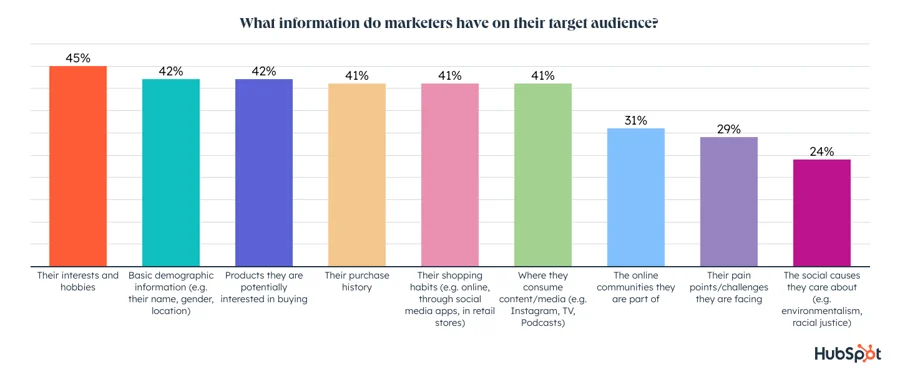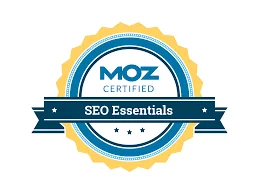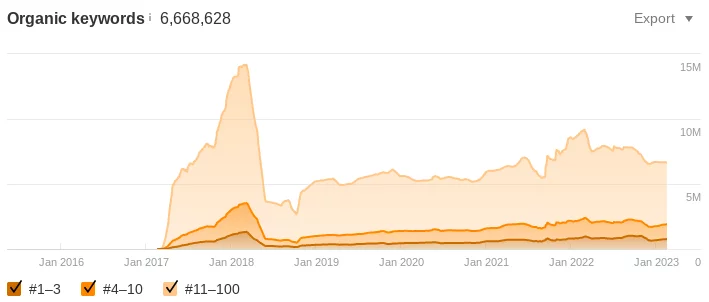Understanding your target audience is the cornerstone of a successful website. Statistics reveal that 89% of marketers believe that understanding their audience’s preferences is crucial for business success. As
‘You’ve got to start with the customer experience and work back toward the technology, not the other way around.’
Steve Jobs
Identifying the right audience involves delving into demographics, psychographics, and market research. It’s about more than just numbers; it’s about connecting with the motivations, interests, and needs of your users.
Benefits of Identifying Target Audience:

- Relevance and Engagement: Tailoring your content to a specific target audience ensures that it’s highly relevant to their needs and interests. This relevance increases the likelihood of readers engaging with your content, as it directly addresses their concerns and questions.
- Improved Content Quality: When you know your audience well, you can create higher quality content. You can use the language, tone, and style that resonates with your readers, making your blog more enjoyable and informative.
- Increased Traffic: Understanding your target audience enables you to optimize your content for search engines. By focusing on keywords and topics relevant to your audience, you can improve your blog’s visibility in search results, attracting more organic traffic.
- Audience Retention: Once you’ve captured the attention of your target audience, you’re more likely to retain their readership. They’ll keep coming back to your blog for content that consistently meets their needs.
- Community Building: Identifying your target audience can help foster a sense of community around your blog. When readers feel like your content speaks to them personally, they are more likely to participate in discussions, share your content, and become loyal followers.
- Monetization Opportunities: If your blog is monetized through advertising, affiliate marketing, or product sales, understanding your target audience is essential. You can promote products and services that are genuinely relevant to your readers, increasing the chances of conversions.
- Efficient Content Creation: Knowing your audience’s preferences and pain points allows you to create content more efficiently. You can focus your efforts on topics that matter most to your readers, streamlining your content creation process.
- Brand Authority: By consistently providing valuable content to your target audience, you can establish yourself as an authority within your niche. This enhances your brand’s reputation and trustworthiness.
- Better Marketing Strategies: Identifying your target audience informs your marketing strategies. You can use social media, email marketing, and other channels more effectively to reach the right people with your content.
- Feedback and Improvement: When you have a clear understanding of your target audience, you’re better equipped to gather feedback and improve your blog. You can use surveys, comments, and analytics to refine your content strategy based on audience preferences.
- Adaptation to Trends: Understanding your audience’s interests allows you to adapt to changing trends and developments within your niche. You can stay ahead of the curve by creating content that reflects current interests and concerns.
- Long-Term Success: Building a loyal and engaged readership through audience targeting can lead to long-term success for your blog. Over time, this can result in sustained growth and a more influential online presence.
Steps Involved in Identifying Target Audience:

a. Understanding the Significance of a Target Audience
Remember that your target audience is not just a group of faceless visitors. They are real people with unique interests, preferences, and needs. The tools and insights presented here will help you forge a deeper connection with your audience, making your blogging journey not only successful but also profoundly fulfilling.
Tools, Plugins, and Real-Life Pioneers:
- Google Analytics: Our first tool in this arsenal is Google Analytics. This powerful resource is your window into the behavior of your current audience. By setting up Google Analytics for your WordPress blog, you can track key metrics and gain a comprehensive understanding of what resonates most with your readers. It’s not just about numbers; it’s about comprehending the psyche of your audience.
- Yoast SEO: The next tool in our lineup is the Yoast SEO plugin. It’s not just for search engines; it’s your ally in optimizing your content for the very individuals you want to reach – your target audience. With real-time suggestions, Yoast helps you improve both the SEO and readability of your content. It’s like having a personal SEO consultant right at your fingertips.

To truly understand the power of an audience-centric approach, we’ll delve into the remarkable journey of “The Minimalists.” This duo of bloggers discovered their niche in minimalism and meticulously built a dedicated audience around it. Their success extended beyond the blogosphere and culminated in a bestselling book. Their story serves as a testament to the transformative potential of understanding and catering to your target audience.
b. Identifying Your Niche
Keep in mind that your niche isn’t just a box to check; it’s your compass in the expansive world of blogging. It’s what guides your content creation, audience connection, and ultimately, your blogging success. In the next chapter, we’ll delve even deeper into the art of content creation, equipping you with the skills to craft content that captivates and resonates with your audience like never before. Stay tuned for more insights, tips, and real-life inspirations.
Tools, Plugins, and Real-Life Pioneers:
- Google Trends: Harness the power of Google Trends to delve into the latest trends within your chosen niche. This indispensable tool allows you to spot what topics are currently surging in popularity, offering invaluable guidance for your content creation endeavors.
- Keyword Research Tools: Dive headfirst into the rich universe of keyword research with tools like Ahrefs and SEMrush. These tools are the key to uncovering the precise keywords your target audience is actively seeking. They provide invaluable insights into search volumes and the competitive landscape, enabling you to fine-tune your content strategy.

Let’s draw inspiration from the remarkable journey of Neil Patel, a true luminary in the world of digital marketing. Discover how he harnessed the power of his niche to not only attract a dedicated audience but also to elevate his brand to a position of authority. His story serves as a testament to the transformative potential of embracing and cultivating your niche.
c. Developing Audience Personas
Audience personas are the bedrock of a robust content strategy. They breathe life into your target readers, providing you with invaluable insights to tailor your content to their individual needs and preferences. In this chapter, we embark on a journey that will guide you through the art of creating audience personas, equipping you with a clear roadmap towards content that captivates and engages your audience.
Tools, Plugins, and Real-Life Pioneers:
- HubSpot’s Buyer Persona Generator: Venture into the world of audience persona creation with HubSpot’s free and user-friendly tool. This powerful resource allows you to craft detailed buyer personas, delving into aspects such as demographics, goals, pain points, and more. It’s an indispensable compass on your path to audience-focused content.
- User Surveys: Explore the art of gathering real-life feedback through tools like SurveyMonkey or Google Forms. Learn how to conduct surveys among your existing audience to gain insights that are priceless for refining your audience personas. Your readers’ voices will shape the content that resonates with them most effectively.

HubSpot sought to understand the challenges and issues that their potential customers were facing in their daily professional lives. This understanding was essential in crafting content that would directly address and provide solutions to these pain points. HubSpot didn’t stop at pain points. They delved into the motivations and goals of their audience. They aimed to comprehend what drove their ideal customers, what aspirations they had, and what objectives they were trying to achieve. This insight was crucial in tailoring content that aligned with their audience’s desires and aspirations.
d. Leveraging Analytics Tools
WordPress offers powerful analytics tools that provide invaluable insights into your audience. In this chapter, you’ll learn how to leverage these tools to gather data about your readers and uncover trends that can guide your content strategy. Data-driven decisions are the key to audience targeting success.
Tools, Plugins, and Real-Life Case Studies:
- Google Analytics for WordPress by MonsterInsights: Explore how this plugin simplifies the integration of Google Analytics into your WordPress blog. It provides in-depth reports and helps you understand your audience’s behavior.
- Jetpack by WordPress.com: Discover how Jetpack offers site statistics and analytics, helping you track visitor engagement, site traffic, and content performance.

Buffer’s journey exemplifies the power of data analytics in shaping an effective content strategy. By analyzing audience preferences and adapting their social media posts accordingly, they’ve not only built a significant following but have also cultivated a brand known for its data-driven approach and audience-centric content.
e. Creating High-Quality, Relevant Content
Your content is a reflection of your commitment to your audience. It’s not just about delivering information; it’s about building a relationship of trust and authority. In the upcoming sections, we’ll explore the practical techniques and strategies that can help you master the art of crafting content that truly resonates with your target readers.
Tools, Plugins, and Real-Life Case Studies:
- Grammarly: Grammarly, a leading writing assistant tool, is your invaluable ally in the pursuit of crafting high-quality, polished content. Its real-time grammar and style suggestions offer a critical eye, helping to elevate the quality and readability of your writing. Whether you’re a seasoned writer or just starting your content journey, Grammarly ensures that your content is top-notch, free from embarrassing typos, and in line with the highest standards of language and style.
- Content Calendar Plugins: Maintaining consistency in your content publication schedule is a fundamental aspect of keeping your audience engaged. Content calendar plugins like Editorial Calendar and CoSchedule are the digital blueprints that help you streamline and structure your content plan. With these tools at your disposal, you can efficiently map out your content strategy, ensuring a steady flow of engaging material that keeps your readers coming back for more.

Moz, a renowned SEO software provider, sets a shining example in the art of creating high-quality, educational content. Their in-depth blog posts and guides have become a beacon for those seeking SEO knowledge and insights. By consistently delivering content that provides real value and addresses the needs of their audience, Moz has cultivated a loyal following that eagerly anticipates their next release. Their success underscores the power of educational content in becoming a trusted authority in your niche. Explore Moz’s story for inspiration as you embark on your content creation journey.
f. Promoting Your Blog Effectively
Effective promotion not only increases your blog’s reach but also fosters a loyal and engaged readership. Your journey to mastering blog promotion is a dynamic and rewarding one, and it’s an essential part of your path to blogging success.
- Yoast SEO Plugin: Take a deeper dive into the Yoast SEO plugin. Uncover how this versatile tool can be your go-to resource for optimizing your content for search engines. From fine-tuning meta tags to enhancing readability, it offers a comprehensive suite of SEO solutions.
- Social Media Scheduling Tools: Discover the power of scheduling tools such as Hootsuite and Buffer. These platforms empower you to strategically plan and automate your social media posts, ensuring a consistent and compelling presence that’s vital for attracting your target audience.

The Spruce, a prominent lifestyle website, has mastered the art of leveraging social media and SEO to effectively reach its target audience.

g. Nurturing a Thriving Blog Community: The Art of Audience Engagement
Promoting your blog is the vital bridge that transforms exceptional content into meaningful engagement. This chapter delves into an array of promotion strategies, offering a roadmap to enhance your blog’s visibility and impact. Remember, mastering blog promotion is not just about reaching a wider audience; it’s about creating a deeper connection with those who are genuinely interested in your content.
- Akismet Anti-Spam: Akismet is not just a plugin; it’s your guardian against the menace of spam comments. Maintaining a clean and engaging comment section is paramount for community building, and Akismet assists you in effectively managing spam while allowing meaningful interactions to flourish.
- Social Sharing Plugins: Share the magic of your content with the world by employing social sharing plugins like Shared Counts or Social Warfare. These tools encourage your readers to become ambassadors for your content, sharing it across their social networks and, in turn, extending your blog’s reach.

Neil Gaiman, celebrated author and blogger, is an exemplary figure in the realm of audience engagement. By actively responding to comments and interacting on social media, he creates a bond with his readers that goes beyond the written word.
h. Evaluating and Adapting Your Strategy
In the ever-evolving landscape of the blogosphere, the journey doesn’t end with content creation and promotion. Continuous monitoring, evaluation, and strategic adaptation are the pillars that sustain your blog’s growth and success.
- Google Analytics Custom Reports: Google Analytics is your comprehensive compass in the digital world. Learn how to harness its power by creating custom reports tailored to track the audience metrics that matter most to your blog. These custom insights are invaluable in understanding how your audience interacts with your content.
- Content A/B Testing Plugins: Innovation and adaptation are the hallmarks of an effective content strategy. Explore A/B testing plugins such as Nelio A/B Testing that empower you to experiment with various content variations. This experimentation allows you to pinpoint what resonates most profoundly with your audience and refine your strategy accordingly.

The New York Times, an institution in the world of journalism, is a shining example of a brand that continuously evaluates and adapts its content strategy based on audience engagement. Their story is a testament to the necessity of embracing change and meeting the evolving needs of your audience.
Conclusion:
In conclusion, understanding your target audience is an essential step in building a successful WordPress blog. Identifying and connecting with your ideal readers allows you to create content that resonates with them, driving higher engagement, traffic, and ultimately, achieving your blogging goals. By conducting thorough research, creating buyer personas, analyzing data, and continuously seeking feedback, you can refine your content strategy and ensure that your WordPress blog meets the needs and interests of your audience. Remember that knowing your target audience is an ongoing process, and as your blog evolves, staying in tune with your readers’ preferences and expectations is crucial for long-term success. So, invest the time and effort in discovering and understanding your target audience, and your WordPress blog will thrive in the competitive online landscape.
FAQs on Target Audience:
Is it necessary to continuously update my understanding of the target audience?
Yes, it’s crucial to stay up to date with your target audience’s preferences and changes in the market. Audience behaviors and interests can evolve, and your blog should adapt accordingly.
Can I have multiple target audiences for my WordPress blog?
It’s possible to have more than one target audience if your blog covers diverse topics. However, it’s essential to define and understand each segment separately to effectively cater to their needs.
What are some key metrics to measure the success of targeting the right audience?
Metrics like website traffic, time on page, bounce rate, conversion rate, and social media engagement can indicate how well you are reaching and engaging with your target audience.



